During one remarkable two week period — from April 19 to May 5, 1971 — more than a half-million citizens descended on the nation’s capital for the largest anti-Vietnam War rally, staging sit-ins that clogged entrances to several government agencies, camping out in a park where they put on a rock concert, and blocking streets and bridges that nearly shut down the city.
Hundreds of war veterans joined the fray, lobbied Congress, engaged in civil disobedience at the Supreme Court and the Pentagon, performed mock guerrilla theater attacks on unsuspecting citizens on the city’s streets, and threw their war medals onto the Capitol steps.
The government intensified the chaos on the streets by flying in troops from the 82 Airborne Division, landing helicopters on the National Mall in an echo of military tactics then in use in Vietnam. Police ordered the streets cleared by rounding up some 13,000 protesters and innocent pedestrians alike with many housed in a football stadium — the biggest mass arrest in American history.
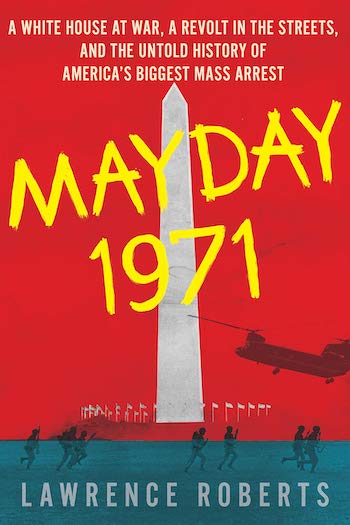
President Richard Nixon would later recall this period as one of “turmoil bordering on insurrection.” Larry Roberts, a Pulitzer Prize-winning investigative reporter, characterizes the scene as “Nixon’s Insurrection City” in “Mayday 1971,” his new, definitive book about what the anti-Vietnam War movement called its Spring Offensive of 1971.
If you’ve never heard about these events, you’re not alone. Most folks under 60 know little or nothing about the Vietnam antiwar movement. And those of us who were alive then can be forgiven if we don’t recall much about what happened, as we’ve had few reminders in the form of books, movies or documentaries.
Still, it’s worth looking back at these events for several reasons. First, the size and variety of the actions has few parallels in the history of social protest movements in American history. Second, the organizers pulled off each of the major actions successfully and nonviolently. Especially noteworthy is the case of Mayday — the effort to disrupt the city’s traffic. And third, there’s good evidence that the Spring Offensive of 1971 did, in fact, achieve its primary overall objective of helping to end the Vietnam War.
To appreciate the size and variety of the Spring Offensive, here is a quick outline of the major actions:
- Operation Dewey Canyon III, April 19-23. Some 1,500 members of Vietnam Veterans Against the War descended on the capital for a week of powerful protests culminating when hundreds of vets hurled their combat medals onto the capitol steps.
- March on Washington, April 24. More than 500,000 participated making it the largest march in the nation’s capital until the Women’s March in 2017. A simultaneous march and rally in San Francisco drew more than 200,000 protesters.
- People’s Lobby, April 26-30. Daily civil disobedience actions when nearly 1,000 people were arrested for obstructing entrances of Selective Service, Internal Revenue Service, Health, Education, and Welfare, and the Department of Justice.
- Rock concert and encampment, May 1-2. Some 50,000 attended a rock concert featuring the Beach Boys in the protesters’ encampment in West Potomac Park. The D.C. police closed down the encampment early on Sunday morning to discourage participation in the next day’s actions.
- Mayday actions, May 3-5. Organized by a group that called itself “Mayday” to refer to their series of actions in early May, an estimated 25,000 activists attempted to block the streets to keep government employees from reaching their offices. Under orders from the Nixon administration, police cleared the streets rounding up of more than 7,000 protesters and innocent pedestrians alike — the biggest mass arrest in American history. Civil disobedience actions the following two days at the Department of Justice and on the steps of the Capital brought the total arrests to over 13,000 for the week.
Previous Coverage
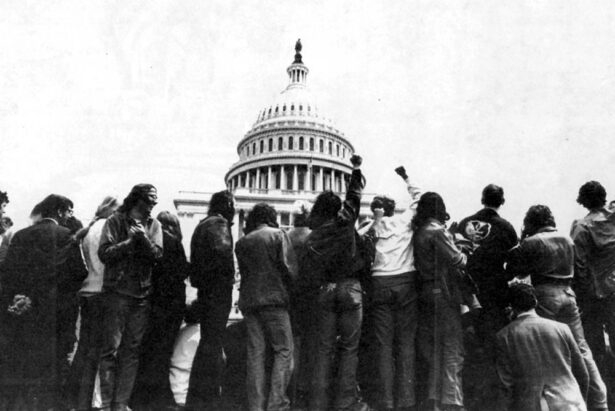 Vietnam veterans descended on the Capitol 50 years ago this week — not to impede democracy but to practice it
Vietnam veterans descended on the Capitol 50 years ago this week — not to impede democracy but to practice itRarely, if ever, has any social protest movement unleashed such a full menu of actions with so many people in such a short period of time. Just doing any one of them would have required all the resources of most causes.
Equally noteworthy, a different group or coalition had primary responsibility for each action, yet they all participated in what amounted to a coordinated assault against those responsible for continuing the war. Leaders of these groups frequently engaged in bitter arguments over politics and strategy. I was sometimes involved in these discussions since I was a coordinator of the People’s Lobby actions. Despite our differences, we all worked out of the same building at 1029 Vermont Avenue NW — on different floors, but we shared the same elevators. We also shared the same goal of wanting the United States to get out of Vietnam yesterday.
The fact that each of the groups was operating autonomously may help explain the tactical success of all the major actions. But there were other factors as well. The massive April 24 rally was the fifth national rally to draw more than 100,000 participants since 1967. By 1971, we knew how to put on a big rally. Many of those responsible for the myriad logistical details had done the same jobs before, and there were no organized groups encouraging violent street confrontations as in 1969 during the massive Mobilization march in Washington. That made the job of marshalling the huge crowd much easier.
Previous Coverage
Mayday’s organizers faced by far the most difficult task of pulling off their action. From its inception the previous fall, the Mayday team planned an explicitly nonviolent action. They did not equivocate on this point nor tolerate violent rhetoric against the police, as happened in 1968 at the Democratic Convention in Chicago.
Mayday’s audacious slogan — “If the government doesn’t stop the war, we’ll stop the government” — appealed to many antiwarriors who felt that participating in a rally was not enough. Another attraction was the novel technique of mobile tactics, where folks would try to obstruct traffic in one location and move to another before the police could make arrests. According to L.A. Kauffman’s 2017 book “Direct Action,” Chicago 7 defendant and Mayday leader Rennie Davis got the idea for mobile tactics from an unsuccessful attempt by the Congress of Racial Equality, or CORE, to paralyze traffic at the opening of the 1964 New York World’s Fair. (Rennie passed away in February at the age of 80.)
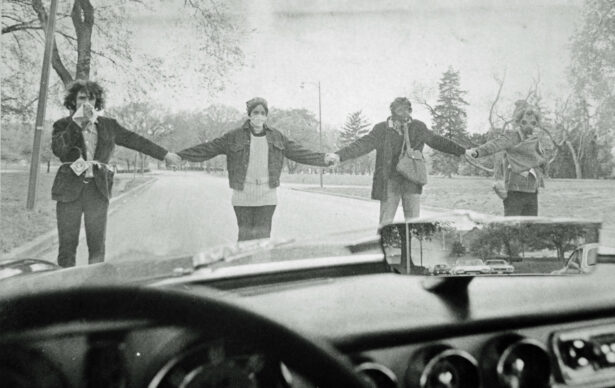
Mayday pioneered another method that’s since been used by hundreds, if not thousands, of progressive organizations: affinity groups. Rather than relying on a centralized leadership structure to direct the action, Mayday organizers told would-be participants to organize themselves into affinity groups of a half-dozen to a dozen individuals. Each group was to blockade a specific target in the city.
In retrospect, the Mayday organizers’ plan sounds like a prescription for chaos with lots of opportunities for government provocateurs to incite the kind of violence Nixon sorely desired. How did they hope to maintain nonviolent discipline with a decentralized structure with participants coming from all over the country?
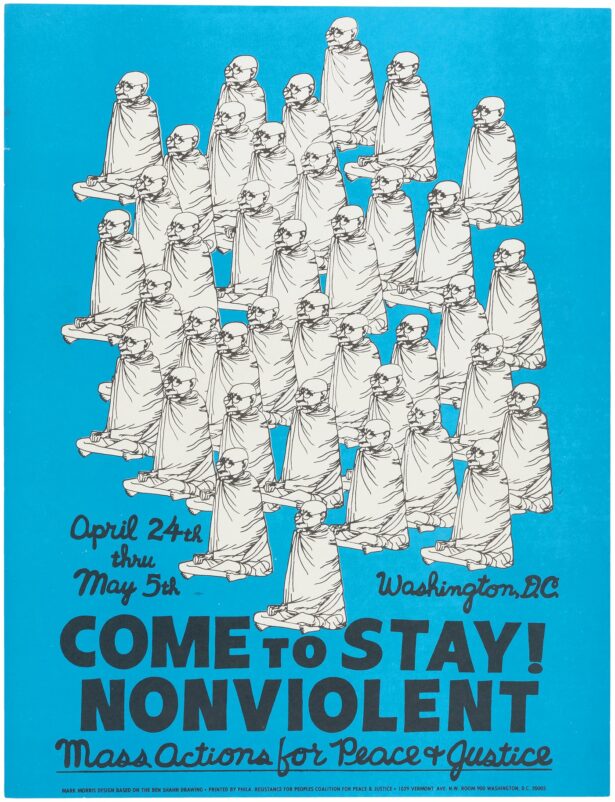
Mayday organizers had two solutions: a written manual and intensive nonviolent training. Jerry Coffin, a Quaker and staffer for the War Resisters League, took primary responsibility for producing the 24-page “Mayday Tactical Manual.” Written in a breezy, down-to-earth style, it provides all the practical details for the action, including maps and photos of the 21 target sites in D.C. They didn’t hide their plans from authorities any more than did Gandhi on his famous Salt March in 1930 or Martin Luther King in the Birmingham Campaign of 1963.
More important, the manual explains the political and tactical rationales: “The aim of the Mayday actions is to raise the social cost of the war to a level unacceptable to America’s rulers. To do this we seek to create the specter of social chaos while maintaining the support, or at least toleration, of the broad masses of American people.”
Mayday organizers distributed the manual widely. At the same time, nonviolent trainers held sessions mostly on college campuses where most of the recruits were. And they conducted nonviolent training continuously at the encampment in West Potomac Park.
By April 1971, nonviolent training had become a regular part of movement actions, and there were training centers in Philadelphia, Chicago, Boston, New York and several other cities — often associated with Quaker organizations like the American Friends Service Committee. (I had been part of a group in Philadelphia.) This core of trainers used techniques like role-playing that could trace its roots back to Rev. Jim Lawson’s workshops in Nashville in the early 1960s. Lawson, in turn, had been deeply influenced by Gandhi. At any rate, many of the trainers had worked other big national demonstrations, such as the big Mobilization march in D.C. when some 5,000 marshals went through training sessions that lasted from one to two hours. (This network has grown dramatically over the years, largely through the work of George Lakey and others to the point that last year in the run-up to the election a group like Choose Democracy did virtual training sessions for up to 10,000 to prepare for a possible coup attempt.)
Another factor was the crucial role played by the People’s Coalition for Peace and Justice, or PCPJ, a large coalition of religious, labor, pacifist, women’s organizations and local peace groups. Some background: After the major national demonstrations in 1969 and 1970, the Mobilization coalition split in two over both political and tactical differences. Both agreed to cosponsor the April 24 rally, but only PCPJ endorsed nonviolent civil disobedience.
Because of concerns about possible violence during the Mayday demonstrations, several pacifist leaders within PCPJ came up with the idea of bridging the time between the April 24 rally and the Mayday actions with a series of civil disobedience sit-ins at different government agencies. That would serve two functions: 1. Set a nonviolent tone for the Mayday actions and 2. Provide a cadre of activists who had already participated in a nonviolent civil disobedience action. PCPJ endorsed this proposal and added another component: lobbying Congress on the People’s Peace Treaty — a serious proposal for ending the war that had been negotiated several months earlier between major Vietnamese and American student groups.
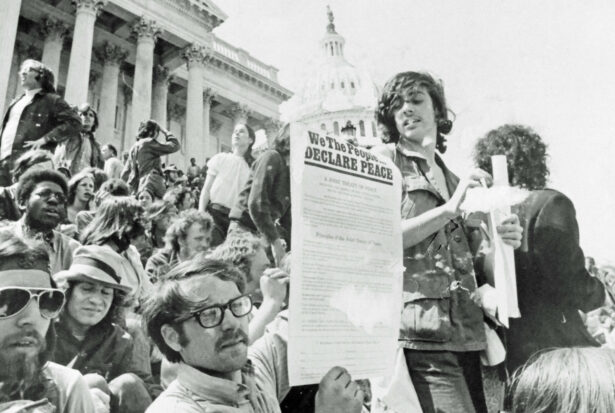
To boost participation in the People’s Lobby, PCPJ encouraged its affiliates to stay in Washington after the April 24 rally. Markley Morris, a Quaker artist who had served time in prison for draft resistance, produced a poster saying “Come to Stay: Nonviolent Actions for Peace & Justice.” It shows several dozen images of sitting Gandhis.
All these efforts paid off. According to Roberts’s book, “despite thousands of frustrated radicals running through the streets, there had been few casualties. There was scattered property damage … The small number of injuries came almost exclusively at the hands of aggressive riot cops wildly swinging their sticks. The pledge of nonviolence … had been kept.”
Mayday’s action on May 3 achieved its main goal of creating the “specter of social chaos.” It did disrupt the usual business of the government, as federal employees were inconvenienced during the morning rush hour, forcing Nixon to helicopter troops onto the Mall and sweep thousands of protesters off the streets, herding them into a football stadium.
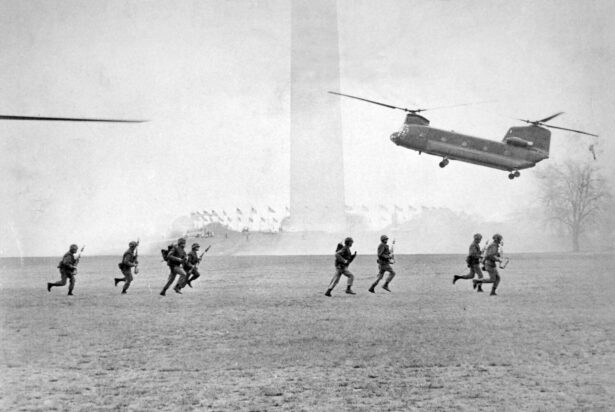
Newspaper editorials mostly condemned the Mayday action. A Washington Post columnist, who had generally been sympathetic with the movement, wrote a scathing condemnation of Mayday, describing how she had to retrieve trashcans that protesters had taken from her elegant house in Georgetown to use as blockades.
Her column reflects the obvious peril of blocking traffic — it can piss off innocent bystanders. Social protest movements do upset the status quo. That’s the point. But it’s important to focus the disruption at the right targets. Nonviolent discipline can keep things from getting out of hand.
However, it’s easy to see how outside observers may not have been impressed with Mayday’s nonviolence. More than 25,000 people engaged in disruptive activities, and there were hundreds of confrontations with police and motorists — more than enough possibilities for unruly scenes that are always the fodder for the mainstream media. If you want to get a feel for how the D.C. police viewed the Spring Offensive/Mayday, you can check out a 28-minute video they produced for other police departments. (I was surprised to see myself at 9:46 in the lower right corner with a handlebar mustache just before being arrested at the FBI entrance to the Justice Department. I’m sure others will spot themselves, too.)
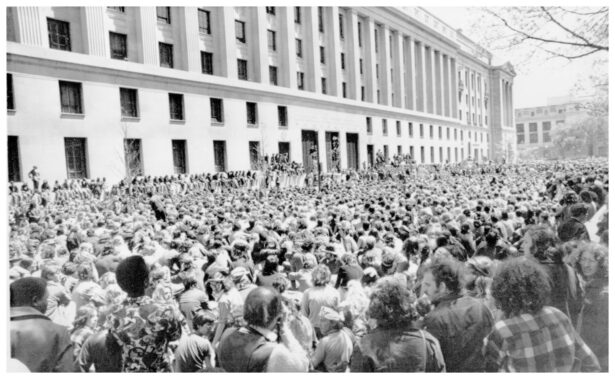
Even if we assume that many, if not most, Americans disapproved of our actions, I’ve seen no reason to believe that Mayday or any of the other components of the Spring Offensive resulted in more Americans becoming more pro-war than before. The antiwar movement had already helped move public opinion over the previous seven years through our marches, rallies, teach-ins, sit-ins, and draft and GI resistance. At the time of the protests, polls showed that 73 percent of the public favored an immediate end to the war, and an astonishing 58 percent believed the war was “morally wrong.” The Spring Offensive aimed to pressure the man in the Oval Office.
There is considerable evidence that the Spring Offensive had a big impact on Nixon. From transcripts of then-secret White House tape recordings, Roberts discloses Nixon’s private thoughts about us: “little bastards,” “animals,” “bums,” “crummy-looking people, the lowest of the low.” For Nixon it was war. He was obsessed with our protests. He received hourly reports on our actions and made all the major, and many of the minor, decisions about how to handle the demonstrations.
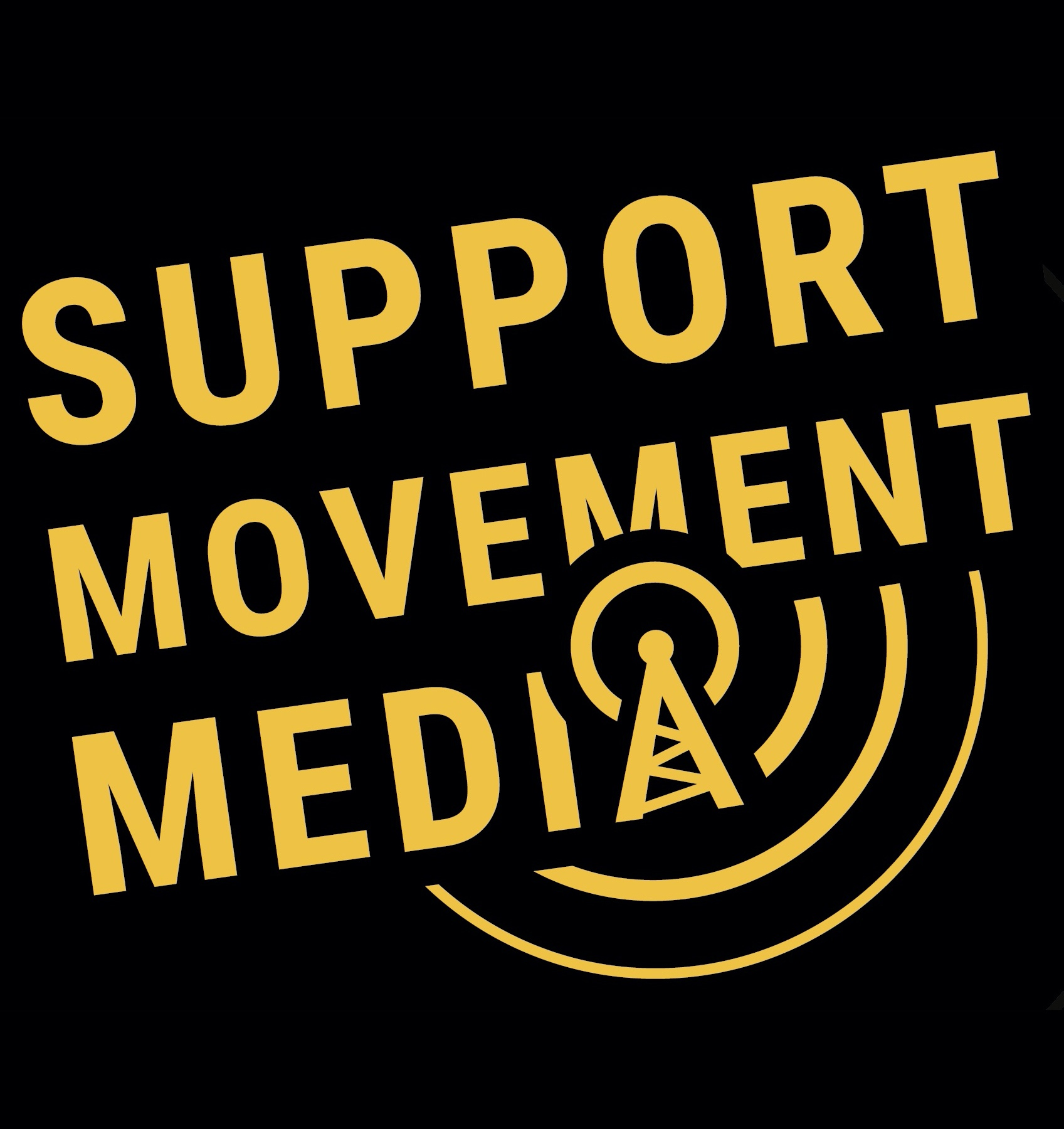
Support Us
Waging Nonviolence depends on reader support. Become a sustaining monthly donor today!
DonateNot only did we rattle the president at the time, Roberts quotes Henry Kissinger as referring to the spring of 1971 as awakening “that uneasily dormant beast of public protest — our nightmare, our challenge and, in a weird way, our spur.” According to Roberts, “The protests certainly contributed to the decision made that season by Kissinger and Nixon to soften” their negotiating position in the peace talks with the Vietnamese in Paris.
Roberts was wrong, however, to write that “The Spring Offensive turned out to be the last hurrah of the American antiwar movement.” It was the last big national action, but the movement continued the fight on many other fronts. The next month, for example, Daniel Ellsberg released the Pentagon Papers. (Ellsberg participated in Mayday in an affinity group with Noam Chomsky and Howard Zinn. The group was gassed but not arrested when they attempted to block a street in Georgetown. A photo of the group is in Roberts’s book.) Nixon’s overreaction to Ellsberg led to Watergate and hampered his ability to continue the war. The following year antiwarriors engaged in numerous acts of nonviolent civil disobedience including many blockades as well as a major lobbying campaign led by Jane Fonda and Tom Hayden that successfully pushed Congressional resolutions that cut off funding for the war.
Though mostly overlooked today, the Spring Offensive of 1971 played a crucial role in making sure that Vietnam did not become a forever war, as has been the case with U.S. wars since 9/11. Our challenge now — even as President Joe Biden pledges to withdraw troops from Afghanistan this year — is to figure out more creative ways to continue the nonviolent struggle against the American war machine. History shows it won’t stop on its own accord.

Super!!! Thanks for this inciteful article.
I came across this excellent article as I was fueling my brain upon the waves of the vast internet ocean for a anti-violence/war piece I was working on.
Thank you.
I’ll share mine should someone want to read this old curmudgeon’s rant.
https://medium.com/the-plan-b-vibe/over-my-dead-critical-thinking-257f007b9472?source=friends_link&sk=b5e111873d5db3c91c3d2d42886a63c4
Nixon and members of the Military Industrial Complex, in particular the generals and state department war hawks, wanted to use nuclear weapons on North Vietnam to win the war. The some total of the anti-Vietnam War Movement, which included the draft resistance, members of the Armed Forces going AWOL or refusing to obey orders, going to Canada, Sweden etc. war tax resistance, the blockading of ammunition trains to ocean ports and other numerous actions and campaigns all over the country and the world, all contributed to not only ending the war but to stopping the escalation to the use of nuclear weapons by the US and to the possible final war of annulation of the planet by a World War III. We learned many valuable lessons and tactics. But we failed to think long term and strategically to go to the root of the problem: militarism and the military-industrial complex. And the addiction to profit by our economic system. Now that is what we need to think and act on now. How do we really achieve a total nonviolent revolution for social, racial, and economic justice without using physical violence against our oppressors? George Lakey, Stephen Zunes, Erica Chenoweth and others have been some of the thought leaders on this because the movement has to be world wide to really be successful and save the whole planet from environmental distruction as well.
Thanks, Robert, housemate and co-worker at Friends Peace Committee! for reminding us of all these actions!–I was there for the full 2 weeks, doing guerilla theater with Vietnam Veterans Against the War, getting arrested at the selective service action, picked up walking down the street during the arrest of the 7,000. It’s important to remember!